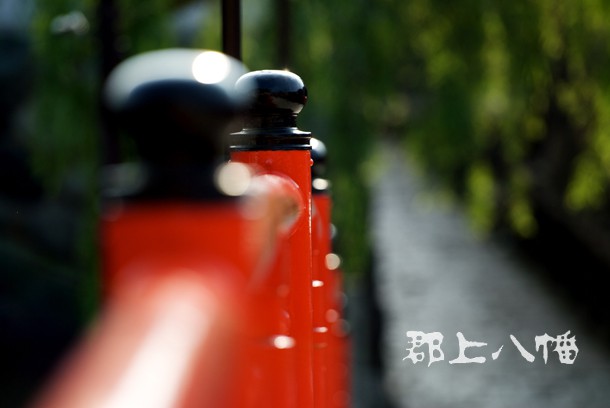
Gujo Hachiman, also known as little Kyoto, is best experienced on foot! You can easily walk just about anywhere in the town, and enjoy an "out of urban" experience that will soothe your soul and inspire you in a way that no large city can.
Check out the two free self-guided walking tours below. Each walking tour includes a full set of detailed instructions and a detailed map in PDF format that can be downloaded and printed.
Download a free town map and walking tour directions. Allow about 2 hours for the full visit which includes the historical centre of town. A self guided river walk tour is also available for free download. It's the perfect way to experience Gujo Hachiman in the Spring and Autumn.
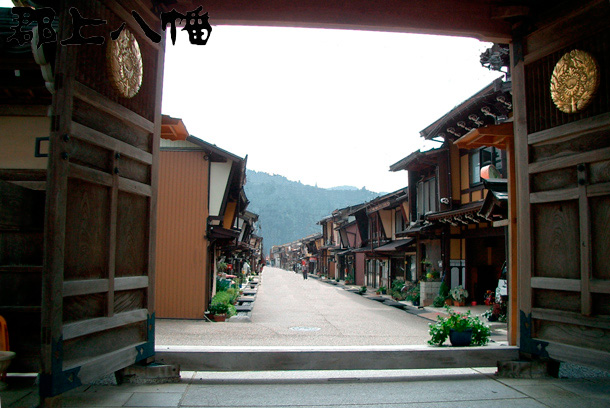
View looking towards Shokunin machi from Cho Kyo Ji Temple
Kajiya machi and Shokunin machi are two of the best preserved streets in the town's central historic district. These two streets, together with Yanagi machi, are included in the national government designated "Important Preservation District for Groups of Historic Buildings" in Gujo Hachiman, and form a significant part of the town's tangible cultural assets.
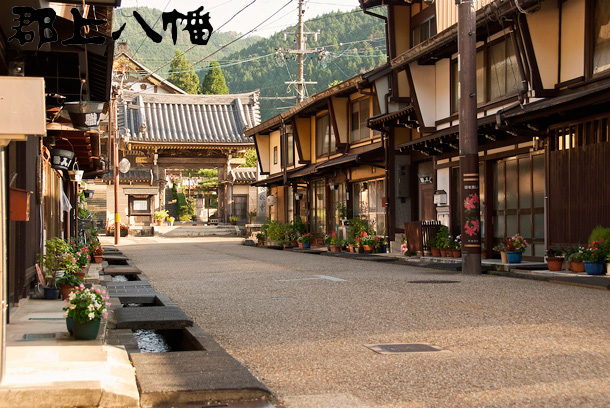
Kajiya machi and Shokunin machi were historically home to the town's craftsmen such as blacksmiths, coopers and carpenters. The houses in these streets feature workshops on the main floor facing the street, with living accommodation above. A few carpenters and tradesmen still live and operate their businesses in this district.
Kajiya machi flows into Shokunin machi, which is anchored by Cho Kyo ji temple. Houses on the west side of the street back on to the Kodara River.
The water channels running along each side of the street were built in 1660 following a tragic fire in 1652 that burned most of the northern area of the town to the ground. They provide fire protection and water for daily household use. If you look carefully under the eves of these houses you can see the black banded fire buckets, and the hansho fire bells used today to provide fire protection and warn others of fires. (Please do not ring these bells!)
A Google Map showing the location of Gujo Hachiman's best preserved streets in the historic centre.
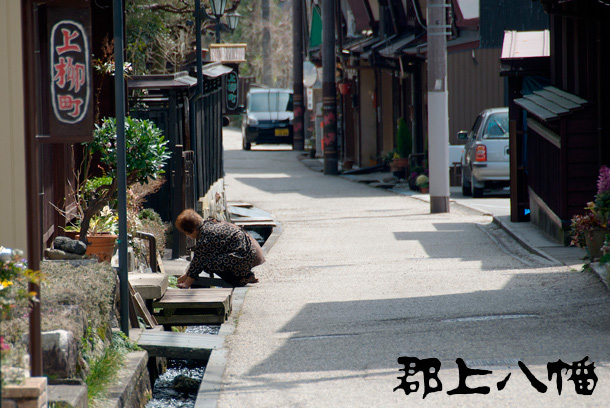
View looking south along Yanagi machi.
Yanagi machi, or Willow Street, is at the foot of Shiroyama, Castle Mountain, and is included in the national government designated "Important Preservation District for Groups of Historic Buildings".
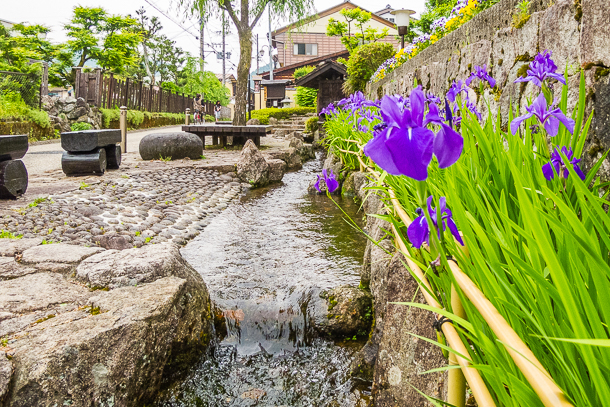
Traditional style houses line the street, and locals still use the water channels for fire protection and daily household use such as washing vegetables or rinsing laundry. The town's largest temple, An Yo Ji is located towards the south end of Yanagi machi, directly behind Jokamachi Plaza.
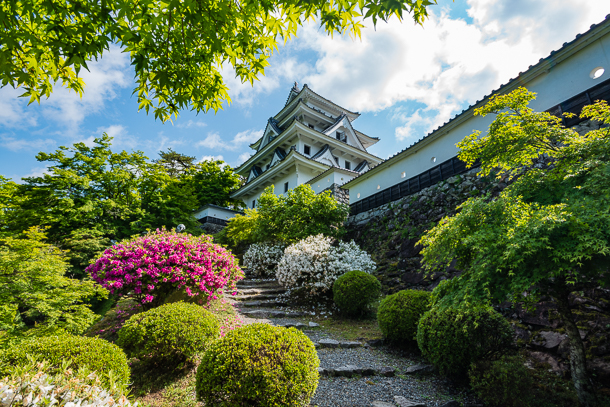
Gujo Hachiman castle is especially beautiful in the spring and autumn
Gujo Hachiman is home to a fine feudal castle that sits on a hill overlooking the valley and the town. The original castle was built in 1559 by feudal lord Endo Morikazu. The original structure was torn down during the Meiji Restoration in 1870, and was reconstructed of wood in 1933. Gujo Hachiman Castle is the oldest reconstructed wooden castle in Japan.
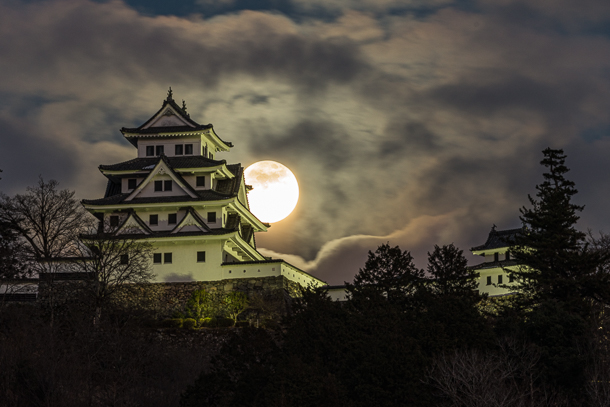
A full moon is almost magical when it rises behind the castle.
The location on Shiroyama (Castle Mountain) was chosen as the ideal location because rivers surrounding the town formed a natural moat protecting both the castle, and a small area at the foot of the mountain below the castle. The castle served as a lookout and home to 19 generations of feudal lords and their families for over three hundred years.
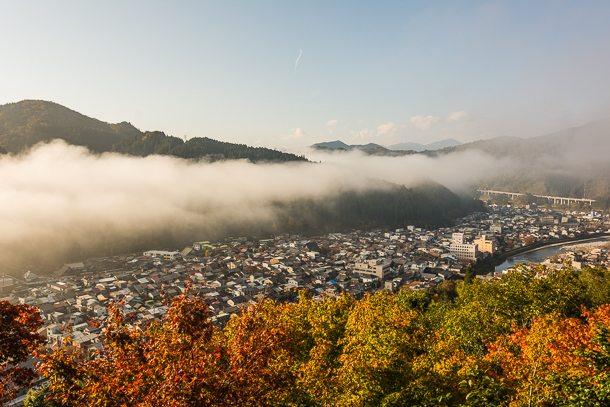
An early morning autumn view of Gujo Hachiman from the castle. Well worth waking up early and the hike up the mountain.
A short hike up to the castle gives visitors a spectacular view of the town and surrounding valley, and is a pleasant, quiet place to sit and relax. Like most castles in Japan, Gujo Hachiman castle is surrounded by cherry trees and is beautiful to visit in the Spring. Admission to the grounds is free. Individual adult admission to inside the castle is 400 JYP for adults and 200 JYP for children. There is also a small museum inside the castle.
Hours of Operation:
March 1 to May 31 09:00~17:00
June 1 to August 31 08:00~16:00
Nov.1 to Feb.28 09:00~16:30
Note: Last admission is 15 minutes before closing time.
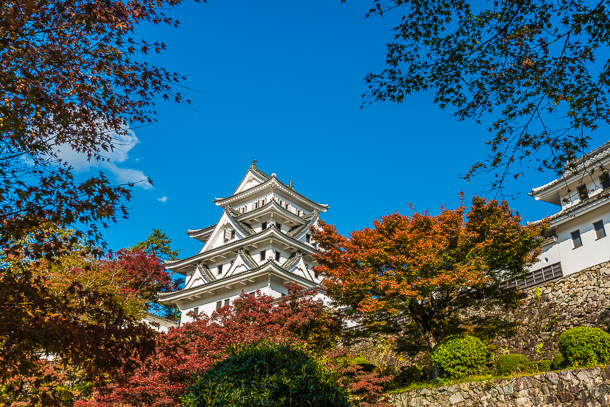
Gujo Hachiman castle is beautiful in all seasons, especially in the autumn
Gujo Hachiman castle is also surrounded by maple trees, which make autumn the best season in which to visit. The annual autumn Maple Leaf Festival (Momiji Matsuri) is held in November and includes tea ceremony and koto demonstrations in a colourful setting overlooking the town.
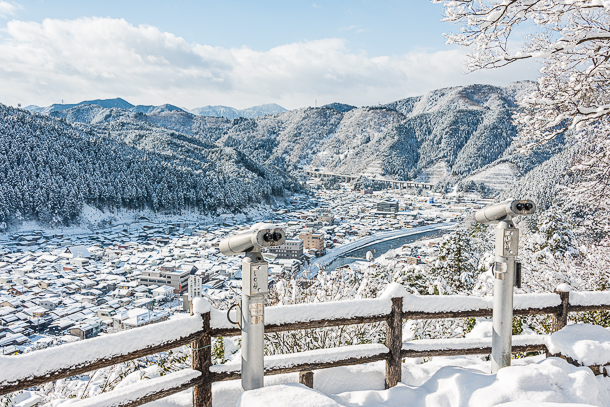
In the winter, the castle and surrounding area take on an almost fairy tale image when it snows.
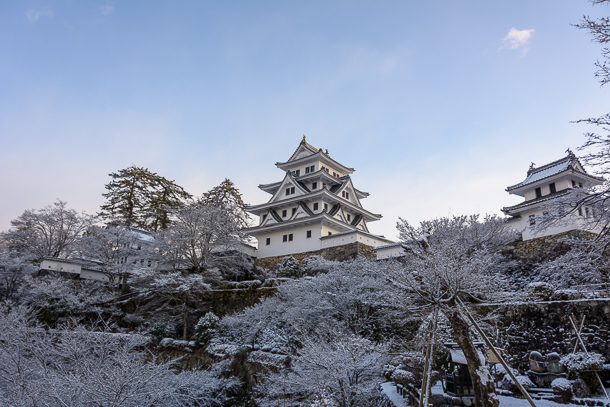
A Google Map showing the location of Gujo Hachiman Castle
Beginning outside the castle entrance and then moving through the entrance, first floor exhibits, then up to the 2nd floor, and finally the top floor with a beautiful view of the town.
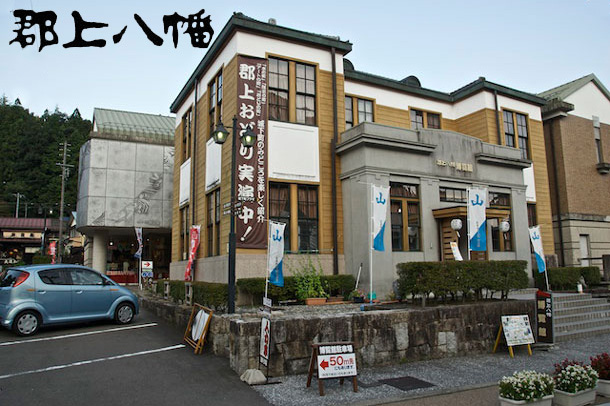
The Hakurankan Museum presents small themed exhibits about the town that include explanations about the local river ecosystems, local handicrafts, and town history.
There are also Gujo Odori dance workshops and presentations daily at 11 am, 12 p.m., 1 p.m., 2 p.m. and 3 p.m. with extra sessions at 10 a.m. and 4 p.m. on Saturdays and Sundays. Lessons feature the two best known Gujo Odori dances - Kawasaki or Haru Koma, last about 15 minutes, and are in Japanese and English. Everyone is welcome and it's not difficult to join in! Find out more about the Gujo Odori Presentation.
There is also a small gift shop located on the main floor near the main exit.
Gujo Hachiman Hakurankan Museum Website - in English
Adult Admission:540 JPY Children 320 JPY. Entry to the gift shop is free. Open daily except for New Year's holiday.
A Google Map showing the location of the Hakurankan Museum.
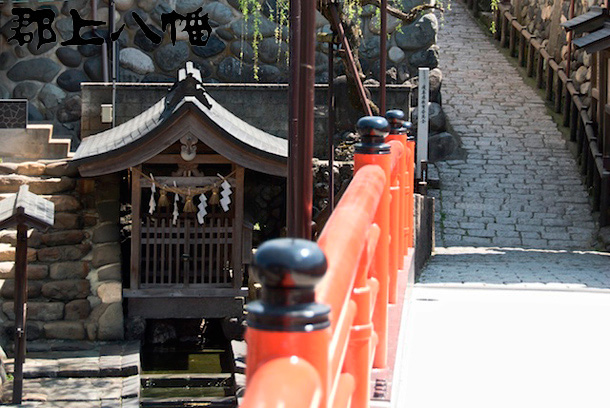
Sogi Sui water spring is the site where fifteenth century poet Sogi and local feudal lord To Tsuneyori exchanged farewell poems when the poet returned to Kyoto after visiting Gujo Hachiman. The water spring and small shrine are recognized by the Japanese Ministry of Environment for both ecological and historical significance.
Sogi Sui is also listed as one of Japan's 100 Remarkable Waters, a list whose purpose is to raise public awareness of natural water and nature conservation. Selection criteria for Japan's 100 Remarkable Waters include history, uniqueness, and local people's effort to protect the sources and are not limited to water quality and preservation of surrounding environment.
A Google Map showing the location of Sogi Sui shrine and a scenic red bridge off of Hon machi.
![]() Sogi Sui Shrine Close Up
Sogi Sui Shrine Close Up
![]() Sogi Sui Shrine and view of the Kodara River
Sogi Sui Shrine and view of the Kodara River
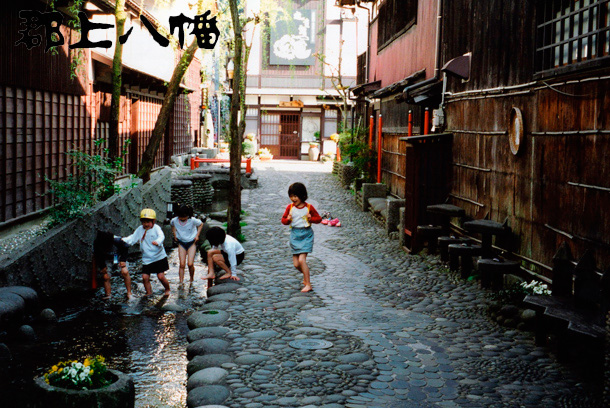
Children playing along the stream beside Yanaka Ko Michi in the summer.
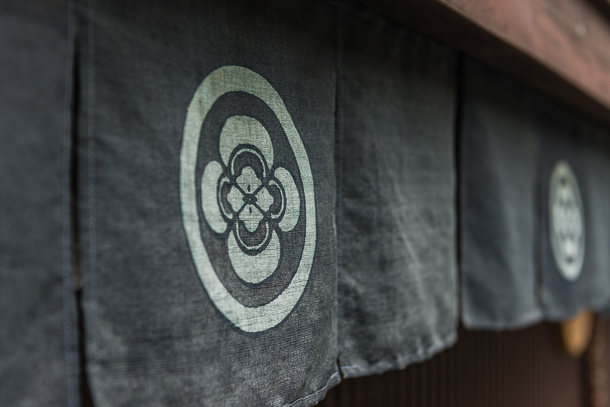
This small street off Shin machi is pedestrian only and is a nice place to relax and people watch. The narrow street is paved with small river pebbles and stones, with a small stream running along one side. A few small willow trees provide shade in the summer.
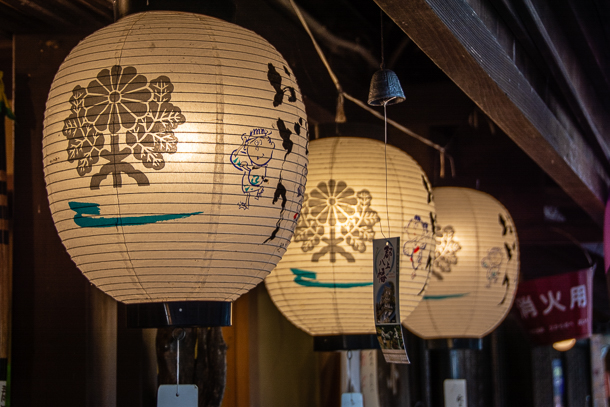
Three small museums are located off this small quaint street.
A Google Map showing the locations of the two small museums located off Yanaka Ko Michi.
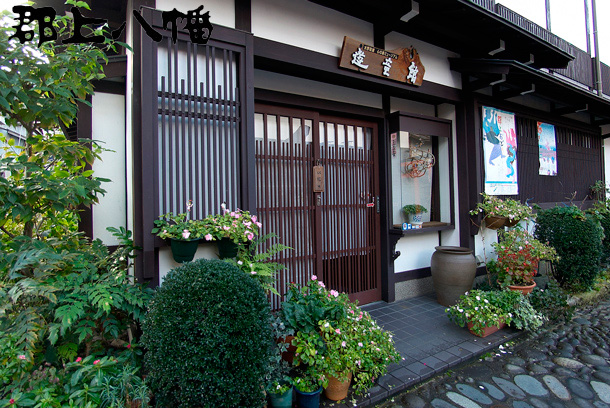
This museum features the work of local artist Masao Mizuno. Whimsical origami are on display, including a large Gujo Odori diorama featuring human and fanciful dancers dancing Kawasaki" in a circle around the main performance float. The museum also displays a collection of the official Gujo Odori posters that Mizuno has created for over 20 years.
Admission: 400 JPY (Closed Thursdays)
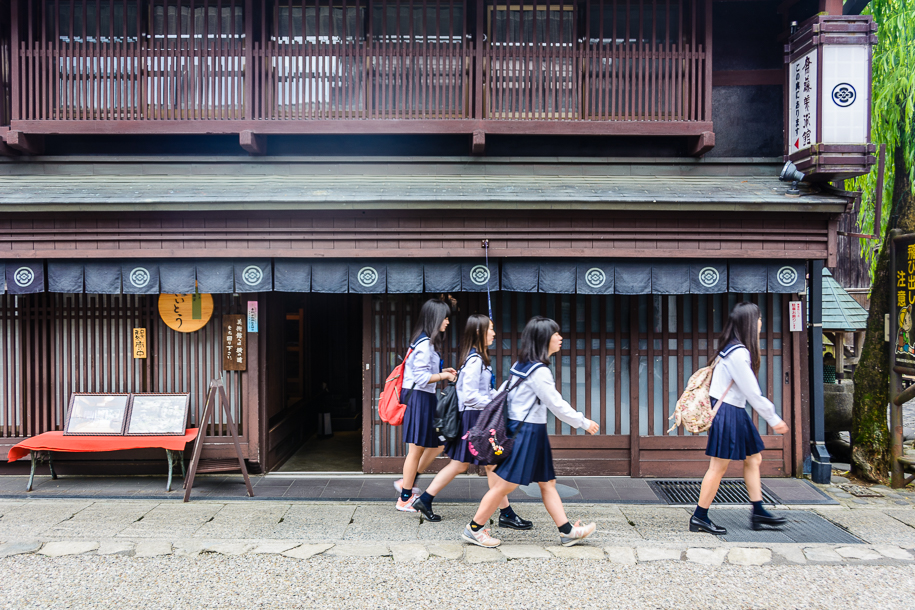
Housed in an historical building characteristic of typical Edo period machiya style architecture, and designated as a registered tangible cultural property, this museum showcases the tea ceremony utensil masterpieces collected by the Saito family over many generations.
Admission: 300 JPY (Closed Thursdays)
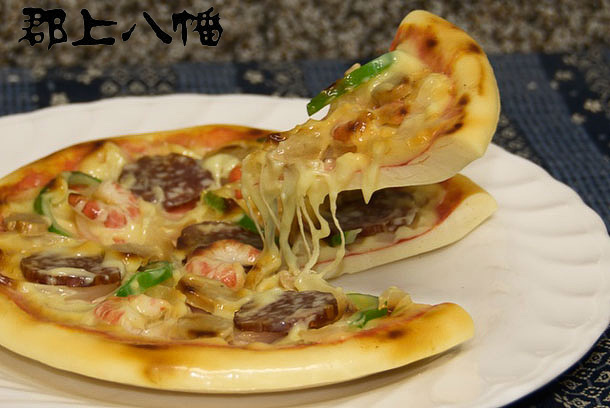
Some food samples are playful and fun.
Few people know that the ubiquitous plastic food replica, seen in front of practically every restaurant in Japan, was invented in Gujo Hachiman. This tradition continues today, with 70% of national production still done in Gujo Hachiman. Some of the large producers offer workshops open to tourists, and there are also a few outlet stores around town where tourist can buy pre-made souvenirs, and even a food-sample themed cafe where visitors can enjoy a coffee, tea or even (real) ice cream.
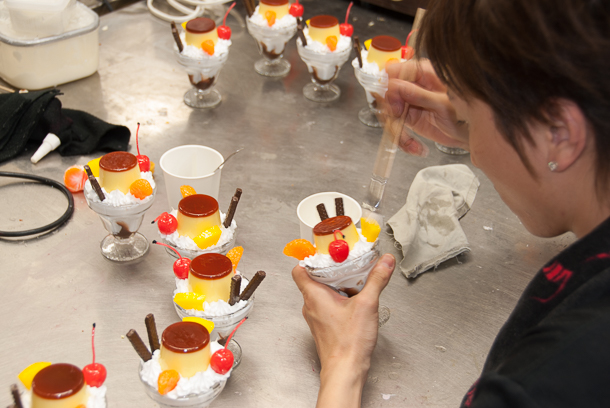
A worker puts the finishing touches on a life-like plastic dessert food sample.
A small fee typically applies for joining sample workshops, and a reservation to attend a workshop is also necessary. Reservations for the typically hour long workshops can be made by phone or in person at most locations. These workshops are very popular with organized tours, and individuals alike.
A Google Map of the locations of the food sample workshops and outlets listed below. All are walking distance from the historic centre area.
![]() Sample Village Iwasaki
Sample Village Iwasaki
TEL: General Inquiries: 0575-65-2832,
Workshop Reservation Number: 0575-65-3378
Workshop: A seperate workshop reservation and fee is required.
![]() Sample Kobo
Sample Kobo
TEL: 0575-67-1870
Store Admission: Free. Retro Museum admission is a seperate fee. Workshop fees apply and include Retro Museum admission.
A workshop reservation is required. Workshops are available in English.
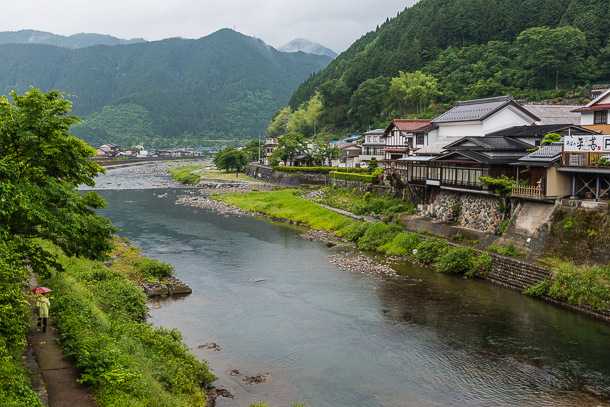
The Yoshida river is beautiful in all seasons, even in the summer rain.
The Yoshida river is joined by the south flowing Kodara river, and runs through the middle of the town as a major tributary to the Nagara River. For many, the Yoshida River is the heart of Gujo Hachiman, while the dance festival the soul.
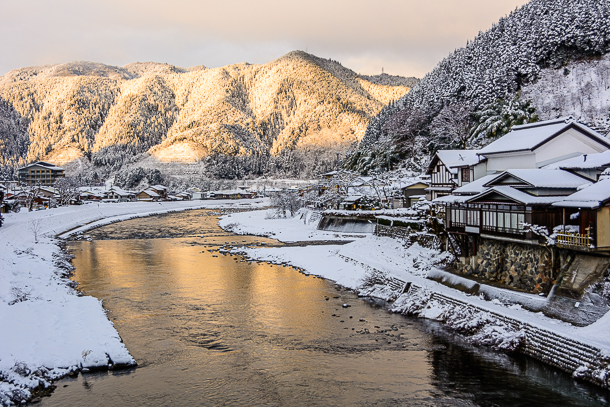
In the winter, the snow in the surrounding mountains and along the riverbanks transform the Yoshida River into a magical winter wonderland
Two main bridges cross the Yoshida river in town - Miyagase Bridge to the west, and Shinbashi bridge to the east. Both bridges offer beautiful views of the river, while the castle can be seen from Miyagase Bridge. In the summer, local children can be seen playing, swimming, and jumping in the cool Yoshida river water. Visitors wishing to swim in the river should take care of the fast current, and quickly changing water levels.
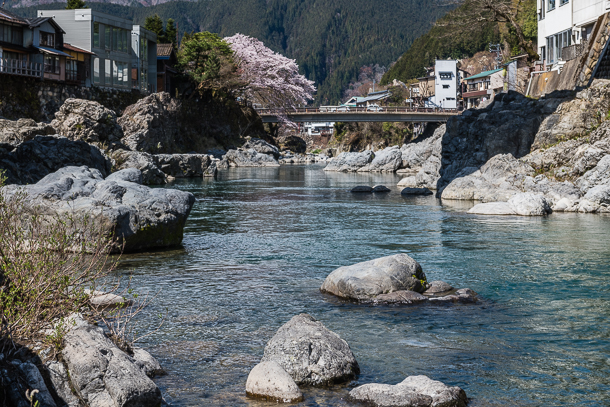
A riverside view of the beautiful Yoshida River in spring.
Visitors can enjoy a relaxing riverside walk and take in views of the castle, watch fishermen fish for ayu and amago in the summer, and of course enjoy beautiful cherry blossoms in the spring. This walk is especially beautiful and calm in the early morning just after sunrise, or in the evening just prior to sunset. Learn more about the role water plays in Gujo Hachiman on our Water page.
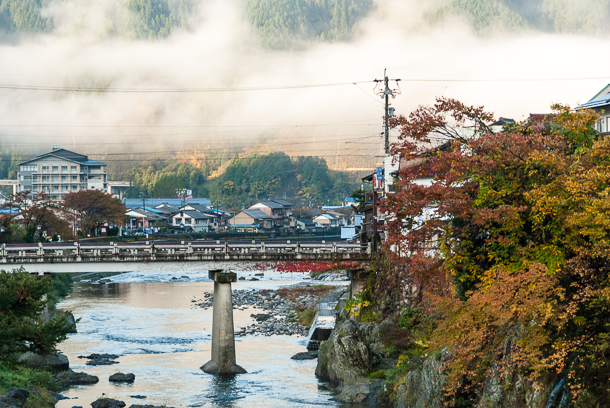
Autumn mist in the morning can be stunning.
A self guided river walk tour is available for free download. Please exercise caution around the river on rainy days as water levels can change dramatically and quickly, and the current can be quite strong.
Walking along the Yoshida River back from the Nagara River will give you beautiful views of the town with the castle in the background at the top of Shiro Mountain. It can be especially beautiful in the spring when the cherry blossoms are blooming.
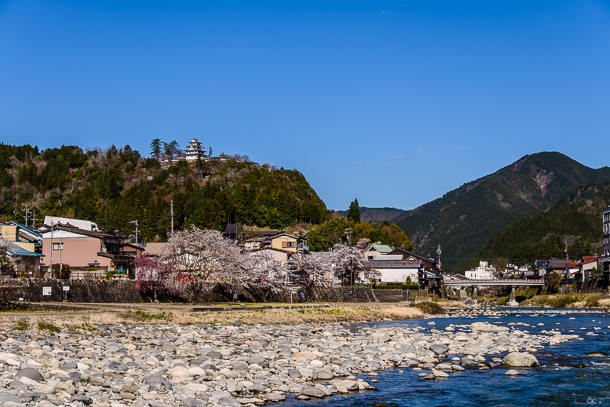
Enjoy a virtual stroll along the Yoshida River.
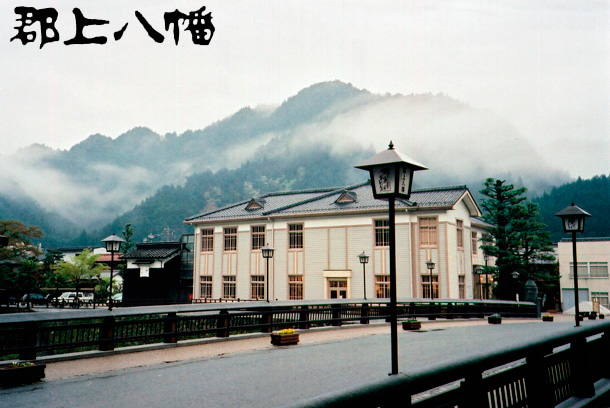
The Gujo Hachiman Kinenkan Tourist Information Centre is a Showa era building and home to the Gujo Hachiman Tourism Association. Here, visitors can find maps, information on local accommodation, and other tourist information. There is also a gift shop featuring made in Gujo Hachiman gifts, and a small coffee shop that sell teas, coffee and light snacks.
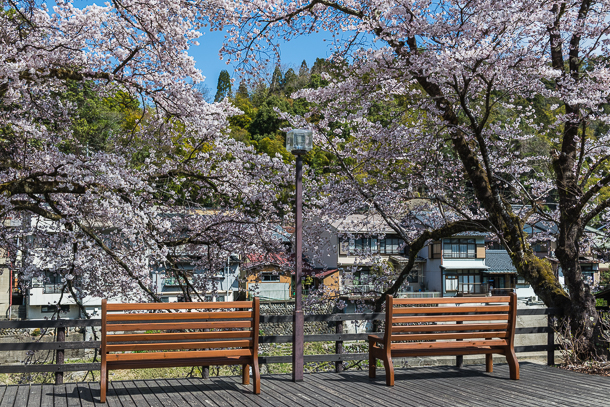
Outdoor benches overlooking the Yoshida River are perfect for resting and enjoying a snack with a cup of freshly made green tea. The large cherry tree behind the Kinenkan adjacent to the parking lot is spectacular when in bloom in late March/early April.
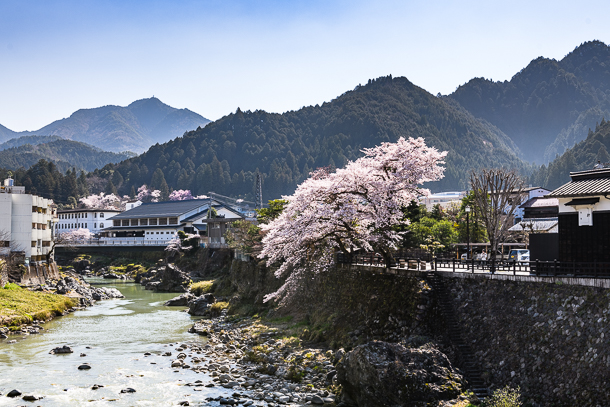
Entrance Fee: Free (Only closed for New Year's Holiday)
Visit the Website (Japanese Only)
A Google Map showing the location of the Kinenkan Tourist Centre.
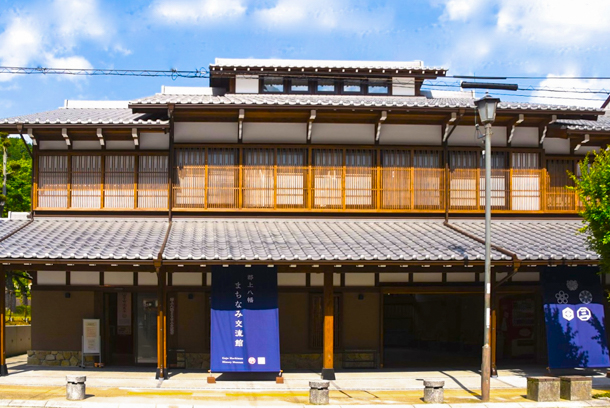
Gujo Hachiman Kitamachi (northern) district is designated an Important Preservation District for Groups of Traditional Buildings under the Law for the Protection of Cultural Properties. Many streets in the area have well-preserved traditional style houses typical of a castle town, and the streets all have small canals on each side.
In the centre of this historical area the Gujo Hachiman Machinami Koryukan, using dioramas and other exhibits, explains the history of the castle town and the characteristics of the houses and the historic area.
This area is included in our free town map with walking tour directions. Allow about 2 hours for the full visit which includes the historical centre of town.
Admission to the Gujo Hachiman Machiinami Koryukan is free, so please feel free to drop in before taking a walk in the area.
Closed days every Wednesday.
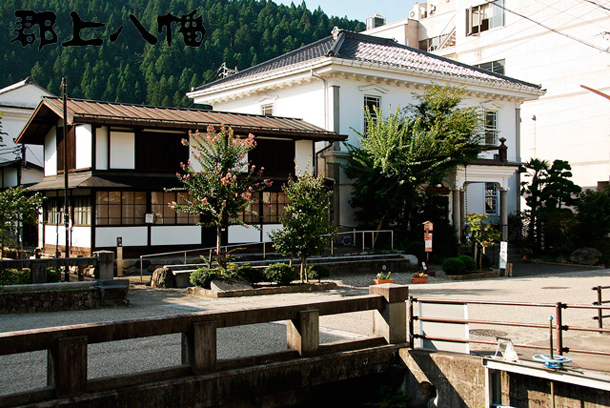
The Rakugeikan is a small museum that features changing exhibits. The main building is a former Showa Era hospital, and showcases medicine and medical instruments from the Showa era. The annex is an Edo period samurai house showcasing town history from the Edo period.
Entrance Fee: 220 JPY (Closed Mondays)
A Google Map showing the location of the Gujo Hachiman Rakugeikan Museum.
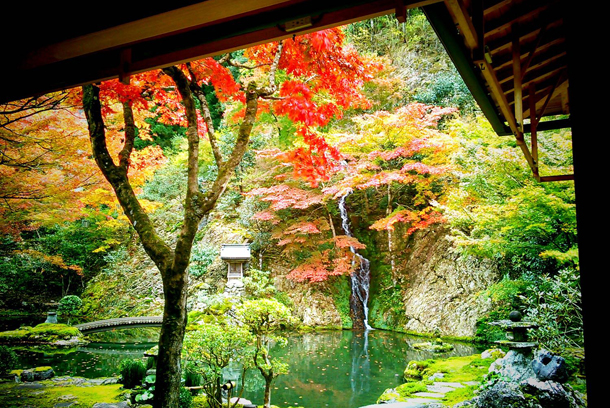
An autumn view of the stunning garden at Jion Ji zen temple
Established in 1606, this small, peaceful Zen temple features a stunning Japanese garden complete with pond and waterfall. The garden is especially beautiful in Spring and Autumn.
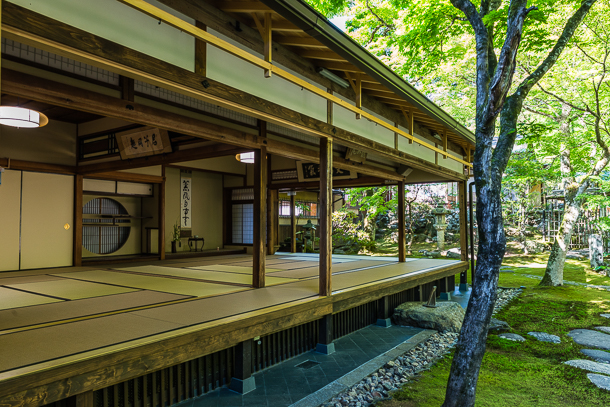
The zen garden in spring. Quiet and peaceful - perfect for meditation.
Admission Fee: 500 JPY
A Google Map showing the location of Jion Ji zen temple and garden.
Industrial screen printing machines were invented in Gujo Hachiman in the 1950's. This technology quickly spread around the world. Today, two of the world's largest screen printing machine manufacturers, the Mino Group and Tokai Seiki are based in Gujo Hachiman, along with about 10 other manufacturers, establishing it as a local industry.
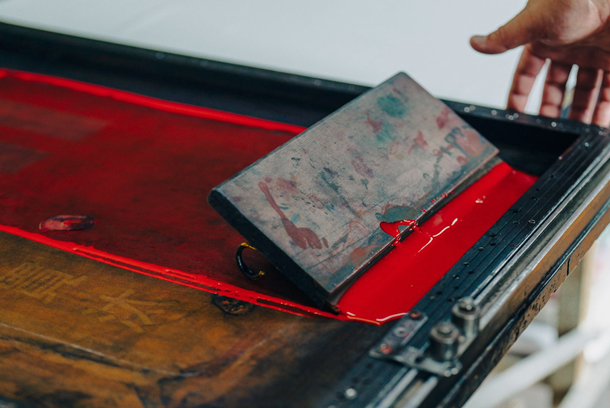
Screen printing is a method of printing simple or complex images where ink is applied through fine mesh materials such as silk or nylon. This technique makes it easy to express original images with shades, such as photographs and paintings, and has been widely used by artists. Tadanori Yokoo and Andy Warhol are just a couple of well-known figures in this field.
Visitors to Gujo Hachiman can choose from two screen printing workshop experiences where you can try your had a making a custom screen printed souvenir. Both offer workshops and are popular so advance reservations are recommended.
![]() Irodori Kobo
Irodori Kobo
Workshop location is seperate from the factory
(fee required for workshop)
TEL: 090-3158-5012
![]() Takara Gallery Workroom
Takara Gallery Workroom
(English workshop available)
TEL: 0575-67-9707
(Fee required for workshop)
A Google Map showing the location of silkscreen workshops in Gujo Hachiman.
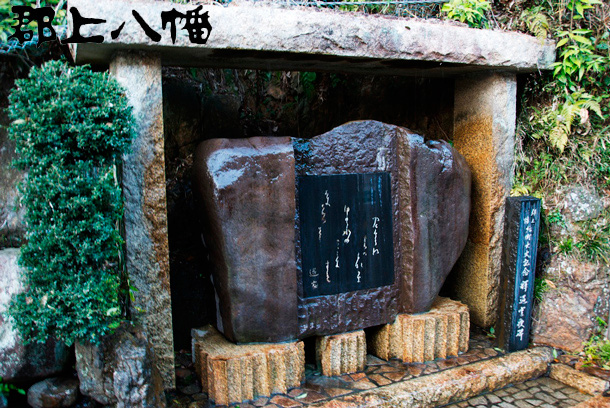
In 1919 poet Shinobu Orikuchi (pen name Shaku Chouku) visited Gujo Hachiman expecting to find a beautiful castle town. Instead he was confronted with a scene of tragedy. The entire northern part of the town had recently burned to the ground in an extensive fire, and many lives had been lost in the fire. As a requiem to the victims of the fire, and to commemorate this terrible event, he wrote this poem, Kahi. Carved into stone and placed at the edge of the area that was destroyed, today the poem is bathed in water to symbolize the hope that the town will never again experience such a terrible event, and to soothe the loss of so many lives.
A Google Map showing the location of the Kahi Poem.
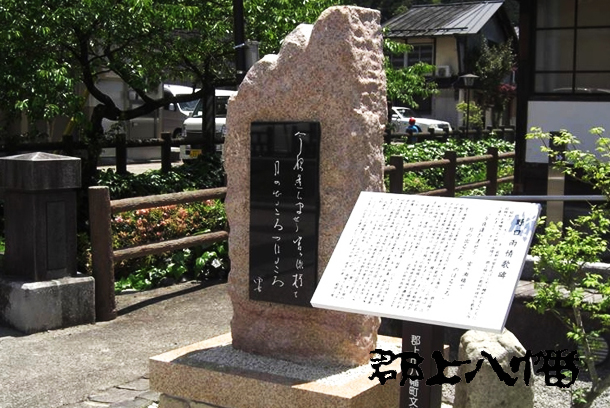
This monument pays tribute to Ujo Noguchi, poet and lyricist of children's songs and minyo folk music. He wrote nine verses of the Gujo Odori song "Kawasaki", and is well known for writing some of Japan's most beloved and familiar pieces for children and youth choirs, such as "Akai kutsu (Red Shoes)". He, along with Hakushū Kitahara, and Yaso Saijō are considered to be the three great poets and children's song-writers of Japan.
Architecture in Gujo Hachiman was heavily influenced in the Edo period by Kyoto. There are several examples of Edo period machiya houses - narrow but very deep houses with very modest fronts. Some properties are designated as registered tangible cultural properties and continue to be well preserved. Most are private residences, but a few, such as Saito Tea Museum, are open for public visits and visitors can experience the hidden world behind the modest spindle latticed street front.
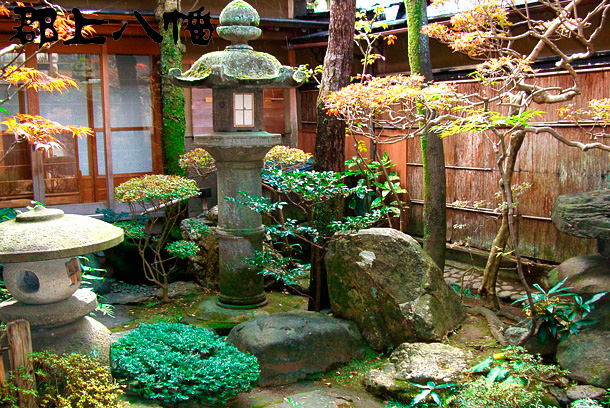
Small hidden gardens, such as the one pictured above, were created in the middle of these deep narrow, elongated Edo period machiya houses. They add much needed light and ventilation and of course are visually soothing and stimulating.
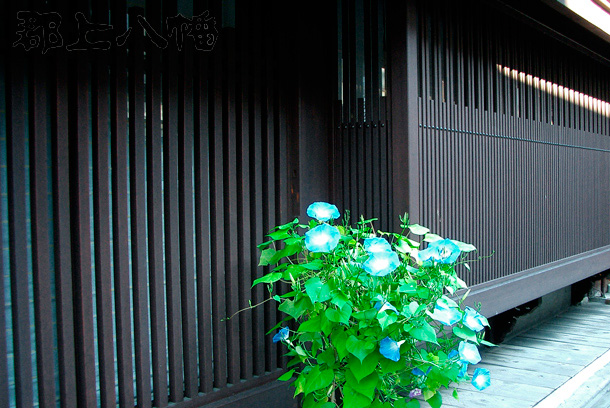
Historically, the latticework of spindles facing the street provided both privacy and security for the owner. Liquor and miso stores feature thick heavy spindles that would not be damaged by being hit by heavy barrels, whereas kimono, thread and other types of stores feature thinner lighter spindles.
The pattern of how the spindles were cut at the top identified the type of store by the need inside the store for natural light e.g. an alternating pattern of one cut spindle indicated a kimono store, whereas an alternating pattern of two cut spindles indicated a thread store.
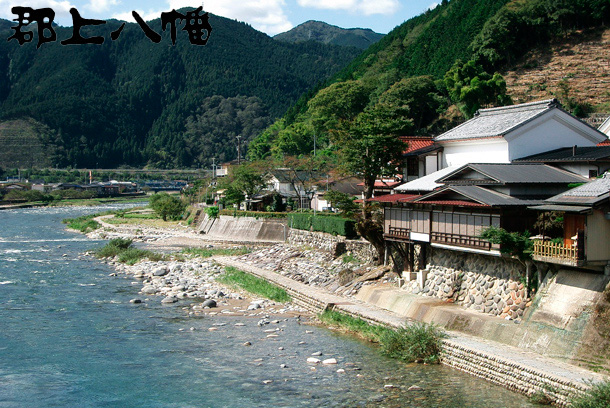
Riverside summer houses feature large semi-enclosed verandahs that overlook the Yoshida river. Designed to catch cool summer evening breezes, these houses are the perfect escape from summer heat, and many are still used today as summer residences and to escape the city on hot summer days.
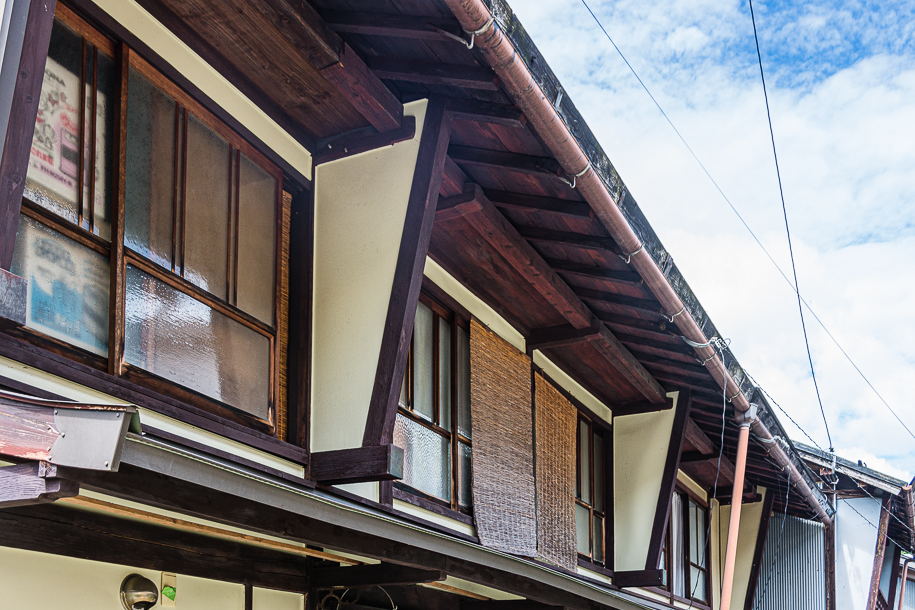
Sodokabe, or "sleeve walls", are architectural features on the upper floor of many of the narrow closely spaced Edo period machiya houses in Gujo Hachiman. These dividers extend out from the edge of the house and down from under the roof. They form a privacy partition from the neighbouring house, provide additional fire protection, and help to support large heavy roofs, especially when laden with snow in winter.
Visit us in person:
Kinenkan Tourism Centre
501-4222
520-1, Shimadani,
Hachiman Cho,
Gujo Shi, Gifu ken,
Japan
Hours:
9:00 am - 5:00 pm daily
9:00 am - 6:00 pm during Gujo Odori season
Phone: 0575 67-0002